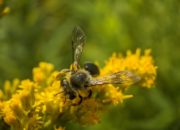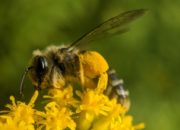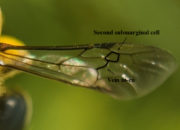This is a uncommon fall asteracae specialist with a strong preference for goldenrod. Only known from a few sites in Vermont, most of which are at least moderately sandy.
Identification: Large, with distinct hair bands on the abdomen. Closely related and visually similar to two more common fall species (Aster Mining Bee and Sunflower Mining Bee). The three species seem to separate out by host plant pretty well, though not always. Males of all three species have yellow on the clypeus (face) and are more likely to visit a variety of flowers. To confirm Andrena braccata females look for sparse brownish hairs on the thorax, strong hair bands on the abdomen (interrupted on T2), and wing vein m-cu meeting the second submarginal cell before middle of cell (see image above).
Similar Species: Aster Mining Bee (Andrena asteris) – Hair band on the second abdominal segment (T2) tends to be complete on A. asteris but usually interrupted on A. braccata. Females tend to have a thick coat of pale yellow hairs and a preference for asters, though also they also visit goldenrods. Also look for brown hairs on T5 of female A. asteris (white/orange on A. braccata). Males have a small amount of yellow adjacent to the yellow clypeus, which is distinct among fall active species in VT.
Sunflower Mining Bee (Andrena helianthi) – Hair bands on abdomen less distinct than A. braccata and interrupted in the middle. Usually on Sunflower. Hair color generally pale orange.
Known or Suspected Parasites: Nomada electa
Global Status: Not Ranked
Vermont Status: Not Ranked
For more information, visit the following links:
Discover Life
Living Atlas Species Page
Distribution: To see the global distribution, check out the iNaturalist account, and toggle the GBIF layer on the map.









